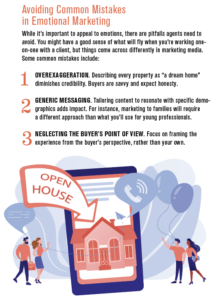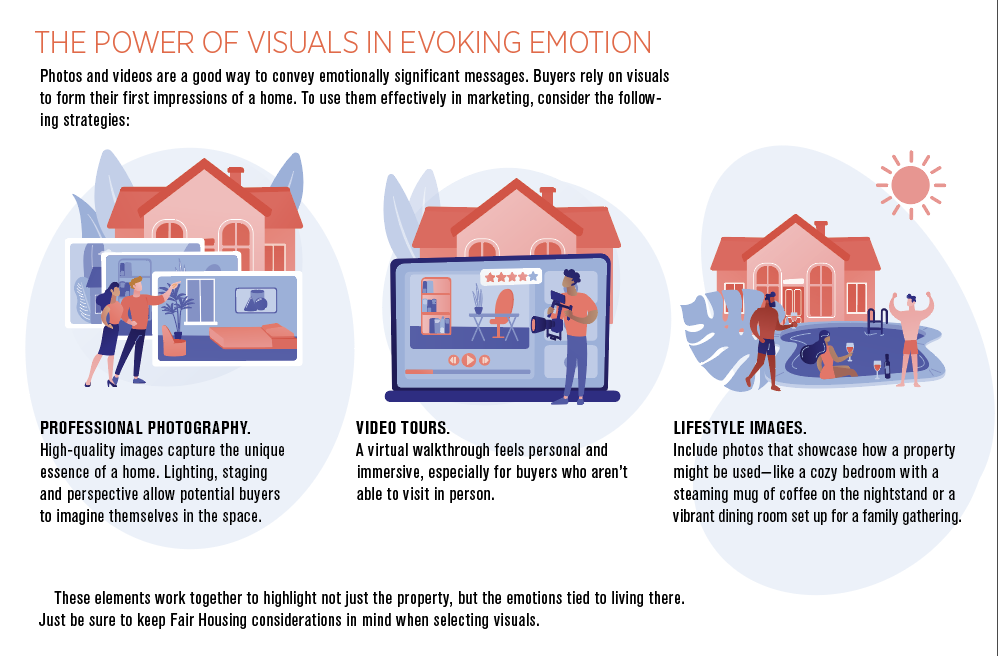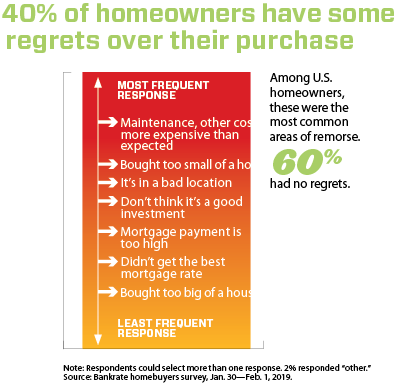By Myrna Traylor
For real estate agents, understanding what drives buyers is crucial to creating successful marketing strategies.
Beyond the tangible features of a property, emotions play a significant role in the decision-making process. By tapping into those emotional triggers, agents can create compelling, memorable marketing that resonates with buyers on a deeper level.
Emotional Factors that Influence Homebuyers
When choosing a home, buyers often look for more than just square footage or location—they imagine a lifestyle. Marketing with emotional resonance can include appeals to:
- Security and stability. A home represents safety and a foundation for loved ones. The desire to create a secure environment can heavily influence purchasing decisions.
- A sense of belonging. Buyers want to envision themselves in a community where they feel welcome and connected, whether it’s an area with great schools or a neighborhood bustling with culture.
- Dreams and aspirations. For many, purchasing a home is a milestone—a symbol of achievement and success. Aligning with these aspirations can make a property irresistible.
Recognizing these factors can help agents tailor their marketing narratives in ways that address buyers’ deepest motivations.

Using Storytelling to Build Emotional Connections
Storytelling is the bridge between data and emotion. It transforms listings from static descriptions into homes full of possibilities. Successful real estate storytelling often involves painting a vivid picture of what life could be like in a home.
CRS candidate Daniella Stanfield, REALTOR® and co-founder of boutique group Elevé Properties, a member of COAST brokered by eXp in the Bluffton/Hilton Head, South Carolina area, is a member of a top-performing team in the state and one of the top 15 in the country. She says that finding the right emotional appeal is intrinsic to her marketing.
“This is a huge part of what I do within our group,” says Stanfield. “All of our marketing is emotional, story-based and lifestyle-based. I hesitate to even call it marketing. What we’re looking to do is connect with people: You want to find them where they are and figure out what they care about, what matters to them, what they are wanting or needing in their lives. Then, how we as agents can bring the proper solutions—whether that’s a particular home or, on the selling side, a suite of advocacy services.”
Stanfield points out that “you can’t emotionally connect if you don’t have any sort of connection points, and those baselines come from stories.” These stories can flow both ways. Those you hear from current and past buyers and sellers can inform the stories you tell prospective clients.
For example, rather than saying “Three bedrooms and two bathrooms,” focus on creating relatable moments. For instance, “Imagine hosting summer barbecues in this spacious backyard, with friends gathered around the firepit.”
Or showcase neighborhood charm when describing a home’s setting. “Start your mornings with a walk to the quaint coffee shop just two blocks away, where the barista knows your order by heart,” conveys more lifestyle appeal than providing a map alone.
Ultimately, stories help buyers connect emotionally to a property by allowing them to visualize their lives unfolding there.
Cultural and Generational Differences
Understanding cultural and generational nuances is key to creating effective marketing strategies. For example, different age groups prioritize unique aspects of homebuying. Millennials (ages 29–44) prioritize experiences. Highlighting accessibility to outdoor activities, vibrant nightlife or eco-friendly features resonates with this demographic. Gen Xers (45–60) also value experiences and are looking for a home that might allow them to be active and age in place. Baby boomers (ages 61–79) focus more on comfort and community. Marketing should emphasize quiet neighborhoods or homes suitable for hosting family gatherings.
Additionally, cultural background impacts which emotional triggers resonate most. Consider the values and priorities of the feeder markets you’re targeting, such as urban professionals in cities or retirees moving into more relaxed surroundings.
Emotional Marketing in Action
To help illustrate how emotional storytelling drives results, consider this example from Kelly Crowe, CRS, a broker at Baird Warner in Geneva, Illinois. She likes to feature stories in the postcards she sends out to prospects. “Every house and transaction has a story, a journey,” says Crowe. “In my marketing, I described how I sold one property three times, telling how the first buyer bought the land, built it as new construction, then sold and moved on. A second client bought it, and then asked me to come in to sell it. The last time, I sold it to a first-time homebuyer. And though we had to look quite a while to find the right home, this was the right home for them.”
This kind of story paints a picture of a house that has been well loved, while at the same time shows how Crowe has been part of that continuity.
Marketing to emotions isn’t about manipulation—it’s about meeting buyers at the crossroads of their dreams and needs. By understanding their motivations, using storytelling and crafting engaging visuals, real estate agents can foster deeper connections with prospective buyers. When emotions lead the way, success will follow.









